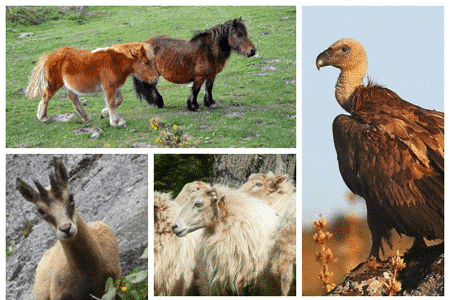Our Basque mountains are home to a wide variety of wild animals. Here’s a small selection of the most emblematic animals you’ll see in their natural habitat during your hikes in the Basque Country. Some are (very) rare, even exceptional, while others are easier to approach. Discover them!

The pottok
The Pottok is a small wild horse from a primitive, hardy breed endemic to the foothills of the Pyrenees. It has been present in the Basque mountains since prehistoric times. In the past, it helped smugglers cross the border between France and Spain. It averages 1.30 m in length and weighs 300 kg. It has a long mane and short ears. In summer, the Pottok wears a brown coat with fine hair, while in winter a thick fur protects it from the elements. In summer, it’s not uncommon to come across these little horses roaming free in the mountains of the Basque Country. During your camping vacation, children can even enjoy a Pottok ride in the hills above Espelette!
La Vache Betisoak
The betisoak (or betizu) cow is a breed of wild cow that lives in the Basque mountains. They are adapted to the harshness of life at altitude, and generally travel in small groups. Betizu cows are medium-sized, with tawny coats ranging from brown to blond. It can be recognized by its lyre-shaped horns, raised upwards and backwards. Now threatened with extinction, the betizu population in the Pyrénées-Atlantiques region is thought to number no more than 150 head.
The Sasi Ardi sheep
The Sasi Ardi is a breed of ewe very rare in the Pyrenees. Its Basque name means “ewe of the undergrowth”. Raised in their natural state, these hardy ewes live on the slopes of Mondarrain or La Rhune. The Sasi Ardi is a very rare breed of sheep in the Pyrenees. The current population is the smallest of the Basque sheep breeds. There are around 1,000 animals on the northern slopes, and twice that number on the southern slopes. By way of example, the Manech Tête Rousse flock, the dominant breed in terms of numbers, currently numbers around 270,000 head in total.
Basque pork
Also known as Porcini Pie Noir du Pays Basque, the Basque Pig is a short-legged Iberian pig with an elongated body and floppy ears. Its light-colored skin is marked with large black spots on the head. An indefatigable walker, they are raised in the open air of the mountains and forage for food in woods and fields. After its near-disappearance in the 1980s, the Basque pig has become famous the world over, thanks to Bayonne Ham!
The Griffon Vulture
The Basque mountains are home to many birds of prey. While the golden eagle is one of the most majestic birds of prey to be found in the Basque Country, it is also one of the most discreet. Vultures, on the other hand, are more discreet, particularly the Griffon Vulture. Starting from the Col de Méhatché, high above the village of Itxassou, the Peñas d’Itsusi circuit allows you to observe these scavengers, which can reach a wingspan of over two meters, in their natural habitat. During the summer, the Hegalaldia nature protection association organizes raptor releases at the summit of La Rhune or at the Col de Mehatze.
The legendary dahu
If you’re very lucky, you might come across a dahu in our Basque mountains. Half ibex, half camel, it’s a very shy wild animal, which makes it all the more difficult to observe. Endemic to the Basque country, the dahu is unique in that its legs are shorter on one side than the other. This physical characteristic enables it to run more easily up mountainsides. However, it can’t turn back, or it will fall… Ready to go on a wild goose chase with the kids in the Basque Country?
The Pyrenean Desman
If your wild goose chase didn’t bear fruit, you may have better luck encountering a Pyrenean Desman. Although! Once a common sight in the rivers and streams of the Basque foothills, this essentially nocturnal animal is very rare and difficult to observe. This semi-aquatic mammal of the Talpidae family (like the moles) is nicknamed the “trumpet rat”, because of the long, proboscis-like shape of its snout. In the Basque Country, the Desman lives at low altitude, along natural riverbanks, near streams and lakes. Only discovered in 1811, the Desman is now a protected species threatened with extinction, notably due to the degradation of its natural habitat.


